Choosing between SEO and SEM strategy seems like solving a puzzle to figure out which one is the best for each business.
But no need to worry! 😎
Today, I’m going to reveal the 7 key differences between “SEO vs SEM” and discuss which approach will be perfect for growing your business ROI!
Let’s begin!
What is Search Engine Optimization (SEO)?
SEO is the strategic approach to optimize a website to improve its visibility in search engine results. The primary purpose of SEO is to enhance a site’s ranking for specific keywords attracting organic (non-paid) traffic.
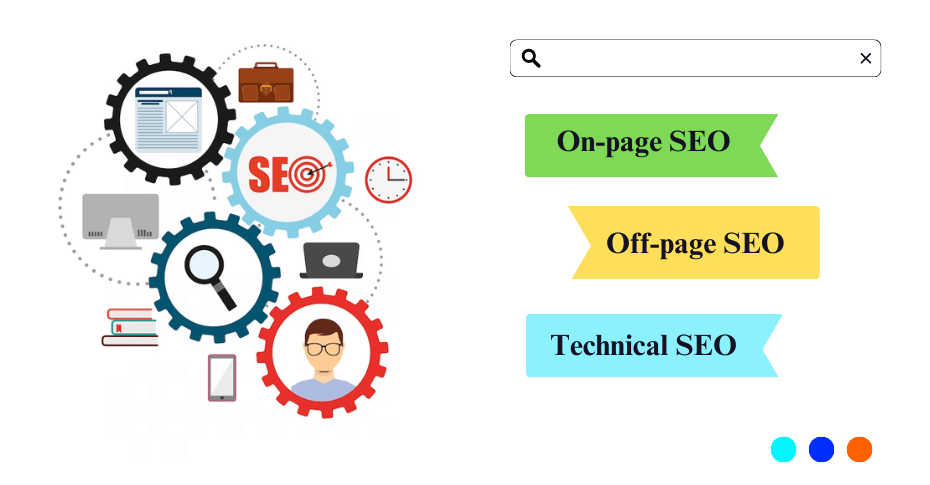
Key Components of SEO
- On-Page SEO: Involves optimizing elements on your website, such as content, meta tags, HTML structure, internal linking, and image ALT tags to improve its relevance to search engines.
- Off-page SEO: Focuses on factors outside your website, like backlinks and social signals, to establish credibility and authority.
- Technical SEO: Enhancing the technical aspects of your website, including site speed, mobile-friendliness, and structured data, to improve search engine rankings.
Methods and Strategies of SEO
- Keyword Research: Identifying the keywords your target audience uses and incorporating them strategically into your content.
- Content Optimization: Creating high-quality, relevant content that aligns with user search intent and optimizing it for search engines.
- Link Building: Getting high-quality backlinks from authoritative websites to boost your website’s authority.
📢 Learn more – SEO FAQs: 50 Essential Questions & Answers for Beginners
What is Search Engine Marketing (SEM)
SEM encompasses comprehensive strategies to increase a website’s visibility in search engine results pages (SERPs) through paid advertising. Its primary goal is to enhance a brand’s visibility and attract targeted traffic quickly.
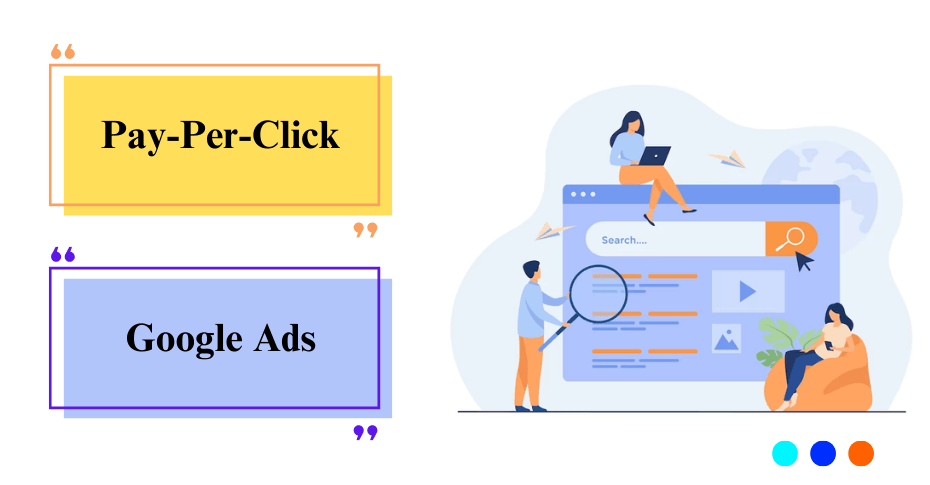
Key Components of SEM
- Paid Advertising: Utilizes paid methods to appear prominently in search engine results.
- PPC (Pay-Per-Click) Campaigns: Advertisers pay a fee each time their ad is clicked, directing traffic to their website.
Methods and Strategies of SEM
- Google Ads: Platform for creating, managing, and optimizing ads across various Google services.
- Keyword Bidding: Involves auction-style bidding on keywords to have ads appear in relevant searches.
- Ad Copy Creation: Crafting compelling ad content that attracts clicks and conversions.
- Landing Page Optimization: Ensuring the landing pages that the ads direct to are well-designed and optimized for conversions.
SEO vs SEM: 7 Key Differences
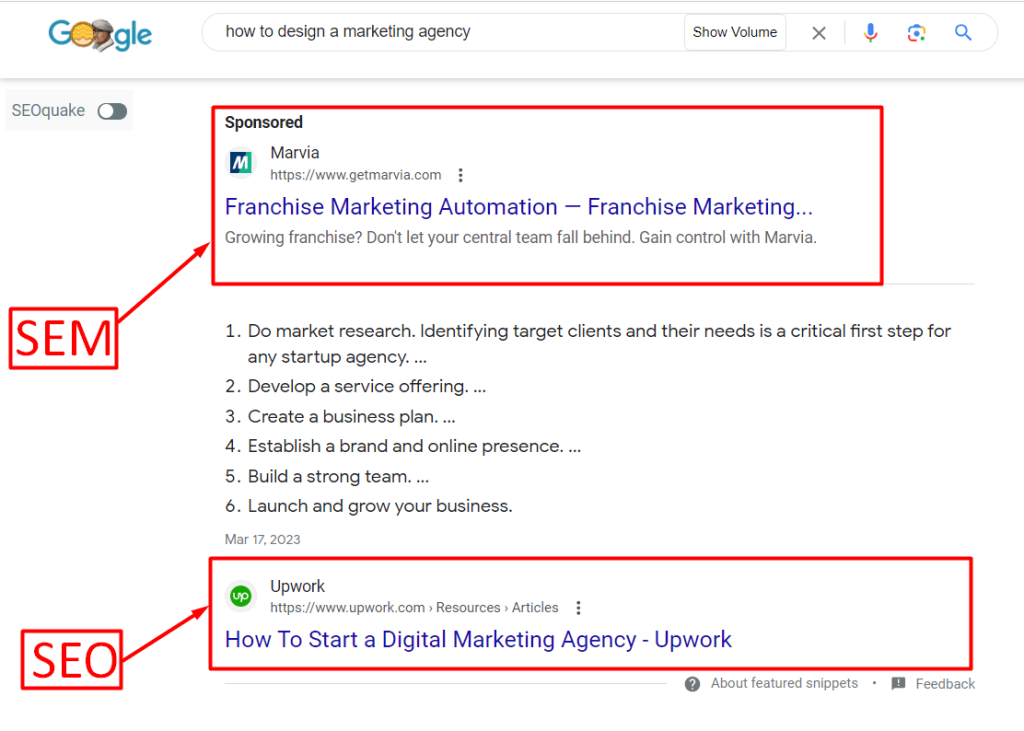
SEO (Search Engine Optimization) and SEM (Search Engine Marketing) are both essential digital marketing strategies for boosting a website’s visibility on search engine results pages.
However, as they involve different approaches and techniques, they have major differences. Let’s explore the 7 major differences between SEO and SEM.
1️⃣ SEO vs SEM: Nature of Traffic
- SEO: Drives organic, unpaid traffic to a website, attracting users seeking information or solutions organically.
- SEM: Generates paid, quick traffic based on ad placements, often targeting users actively looking for products or services with immediate intent.
2️⃣ SEO vs SEM: Placement on SERPs
- SEO: Secures organic placements based on content relevance and authority, appearing below the paid ads.
- SEM: Purchases ad placements that appear mostly above the organic results, sometimes below the organic, marked as ‘Ad’ or ‘Sponsored.’
3️⃣ SEO vs SEM: Timeframe for Results
- SEO: Takes time to build authority and visibility, often requiring a couple of weeks or months to see substantial results.
- SEM: Generates immediate results once the campaign is active, providing instant visibility and traffic.
4️⃣ SEO vs SEM: Longevity for Results
- SEO: Long-term results with consistent effort, maintaining visibility even after efforts are paused.
- SEM: Results are instant but cease once the ad campaign stops or the budget runs out.
5️⃣ SEO vs SEM: Control over Outcomes
- SEO: Offers limited direct control over the ranking on search engines; focuses on optimizing content and following best practices.
- SEM: Offers direct control over ad targeting, budget, ad content, and placement.
6️⃣ SEO vs SEM: Effective Tools
- SEO Tools: Popular SEO tools include Ahrefs, Moz, and Google Search Console.
- SEM Tools: Google Ads, Bing Ads, Facebook Ads Manager, etc are reliable search engine marketing tools.
7️⃣ SEO vs SEM: Cost Structure
- SEO: Involves initial and ongoing costs for optimization, content creation, and technical improvements.
- SEM: Requires a direct budget for every click or impression; costs depend on bidding, keywords, and ad quality.
SEO vs SEM: Pros and Cons
| Pros | Cons | |
| SEO | 🟢 Long-term sustainable results 🟢 Establishes credibility and trust 🟢 Cost-effectiveness over time 🟢 Enhances brand visibility and authority 🟢 Higher click-through rates for organic results | ⭕ Time-consuming to see significant results ⭕ Limited immediate control over changes in rankings |
| SEM | 🟢 Immediate visibility upon campaign activation 🟢 Precise audience targeting and segmentation 🟢 Measurable and trackable results 🟢 Enhanced brand exposure and awareness 🟢 Quick and targeted traffic acquisition | ⭕ Can become costly, particularly in competitive industries ⭕ Results are temporary and cease once the ad budget stops |
SEO vs SEM: Which is the Right Choice for Your Business
So, which one is the right choice for your business: SEO or SEM?
Well, determining the optimal approach that aligns with a business’s unique objectives and market demands has become pivotal in establishing a robust online presence.
So, let’s find out the 5 considering factors while choosing between SEO and SEM for your business:
✔️ Business Goals and Objectives
Understanding the primary goals is crucial, so determine your primary goals before choosing between search engine optimization and search engine marketing.
- If you aim for immediate visibility and quick results, SEM might be more suitable.
- If you’re focused on long-lasting growth and sustainable organic traffic, SEO could be the way to go.
🔍 Target Audience and Intent
Recognizing the audience’s behaviour and intent is also considered a factor in deciding between SEO and SEM, as each brings to different stages of the customer journey.
- If they typically search for products/services that fulfil a prompt need, SEM might be advantageous.
- If they rely on detailed information or research before making a decision, SEO could be more beneficial.
📌 Competitive Landscape
Analyze the market competition to decide which strategy best suits the business’s position in the market.
- If the market is highly competitive and saturated, combining both SEO and SEM might be a more effective approach to capture both quick wins and sustainable growth.
⌛ Timeframe
Considering the urgency for results is vital, as SEO and SEM operate on different timelines.
- Opt for SEM when your business requires quick results.
- If there’s no hurry for instant visibility and the focus is on sustainable, long-term growth, SEO is the better choice than SEM.
💰 Budget Allocation
The budget determines the feasibility and scalability of either strategy. So, assess your available budget for marketing before choosing the SEO strategy or SEM.
- SEO can be beneficial for businesses with limited budget resources but with a long-term vision.
- SEM will be suitable for businesses with a more immediate budget for advertising and seeking immediate returns on investment, focusing on short-term results.
SEO vs. SEM: Combine Both Strategies for Maximum ROI
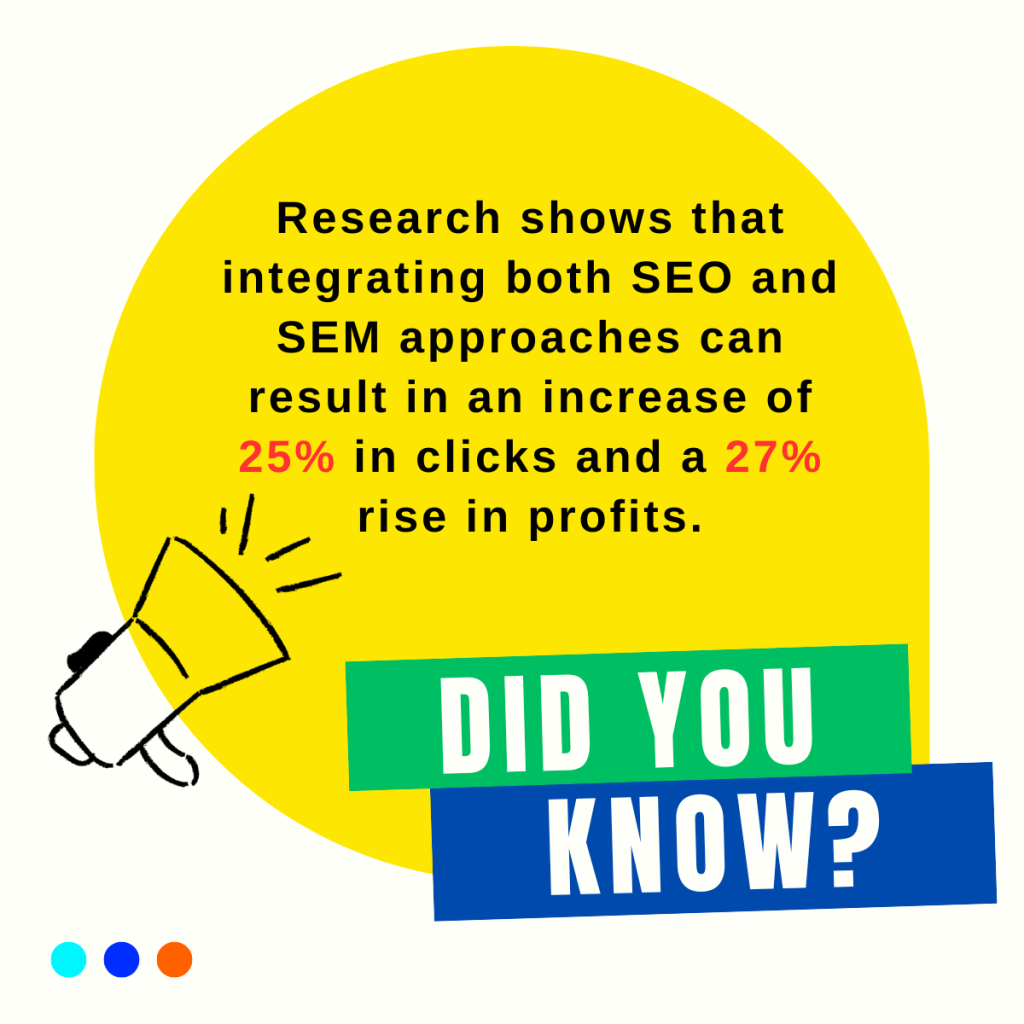
So, merging SEO (Search Engine Optimization) and SEM (Search Engine Marketing) holds the key to achieving the maximum Return on Investment (ROI). They can also bring incredible benefits to your business.
Here are the key benefits of using power duo SEO and SEM
🔥 SEO and SEM collaboration maximizes online presence
🔥 Attracts more visitors to your website
🔥 Boosts credibility and brand recognition
🔥 Engages a wider spectrum of potential customers
🔥 Drives significant impact and growth for your business
How to Combine SEO and SEM
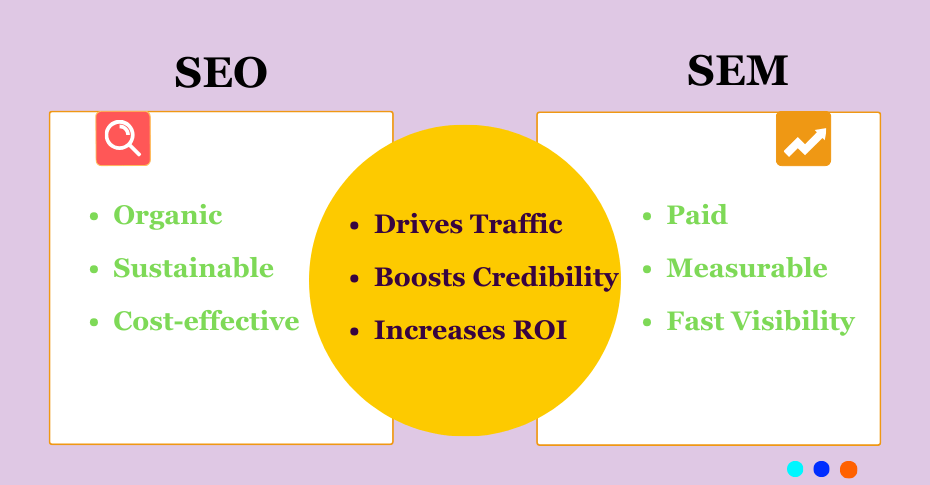
To combine SEO and SEM effectively to increase ROI, you can adopt the following methods and approaches:
Combining SEO and SEM effectively can significantly impact the Return on Investment (ROI). Here are the 5 popular and result-driven methods to merge both approaches for increased ROI:
✨ Keyword Research
- Identify shared high-performing keywords for both SEO and SEM.
- Utilize these keywords to create integrated content for both organic search optimization and paid campaigns.
✨ Content Strategy Integration
- Develop a unified content strategy for both SEO and SEM.
- Craft high-quality, informative and engaging content suitable for organic rankings and adapt it for use in paid search ads.
✨ Cross-Channel Data Utilization
- Combine insights from SEO and SEM to inform strategies.
- Use SEM data to refine SEO strategies and vice versa, leveraging data to improve both channels.
✨ Strategic Bidding and Optimization
- Align SEO strategies with high-performing SEM data.
- Utilize SEM data to identify high-converting keywords and optimize website content accordingly.
✨ Enhanced Landing Page Experience
- Ensure consistency in user experience across both SEO and SEM landing pages.
- Maintain cohesive messaging and design to provide a seamless user journey.
FAQs
1. Is SEO or SEM more important?
Both SEO (Search Engine Optimization) and SEM (Search Engine Marketing) are vital approaches for businesses. SEO is crucial for long-term organic growth, while SEM offers immediate visibility through paid strategies.
2. What type of SEO is best?
The best type of SEO depends on the specific needs and goals of a business. Technical SEO, On-Page SEO, and Off-Page SEO are all essential and should be employed as part of a comprehensive SEO strategy.
3. Is SEO or SEM paid?
SEM involves paid marketing strategies, including PPC (Pay-Per-Click) advertising for immediate visibility. On the other hand, SEO is primarily organic and not directly paid for ranking on search engines.
4. Why use both SEO and SEM?
Combining SEO and SEM offers a comprehensive approach: SEO for sustainable, long-term growth and SEM for rapid visibility, ensuring a broader audience reach.
5. Why are SEO, SEM, and SMM important for business promotion?
SEO (Search Engine Optimization), SEM (Search Engine Marketing), and SMM (Social Media Marketing) collectively enhance online visibility, drive targeted traffic, and build brand credibility, crucial for effective business promotion and growth.
6. Which is a better career path: SEO or SEM?
Choosing between a career in SEO or SEM hinges on individual strengths and preferences. However, SEO demands technical prowess for organic growth, while SEM requires skills in management and immediate impact assessment.
Wrap it Up
To sum up the comprehensive guide on SEO vs SEM, it is clear that, SEO focuses on organic strategies, optimizing content for higher rankings. On the other hand, SEM involves paid advertising for prompt visibility, offering different approaches for gaining traction in online presence.
They both have different strategies but your businesses can significantly maximize ROI by combining these 2 effective methods of digital marketing.